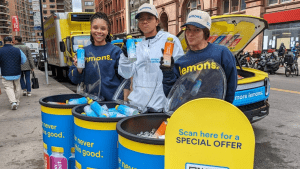Bags Advertisement Is a Hyperlocal Powerhouse for Public Campaigns
When it comes to public outreach, many marketers and health agencies focus on digital channels. But what happens when the audience you need to reach isn’t scrolling — they’re shopping, picking up prescriptions, or heading home with takeout? That’s where bags advertisement becomes an unsung hero of hyperlocal communication.
Whether it’s a bags ad printed on a pharmacy bag reminding patients of flu shots or a bags advertisement distributed via local groceries encouraging recycling — this medium physically enters the hands of residents in the neighborhoods you want to reach.
And when you combine this tactile power with ZIP-code-level targeting, the result is precision outreach that drives real behavioral change.
The Role of ZIP Code Targeting in Bags Advertisement
ZIP-code-level targeting lets brands, agencies, and public institutions deliver localized messages to the right communities, at the right moment. In the context of bags advertisement, this means distributing branded messages through high-traffic venues like:
Pharmacies (ideal for public health campaigns)
Independent grocery stores
Community convenience marts
Delivery restaurants (especially pizza or takeout bags)
This type of bags advertising ensures your message isn’t just broad — it’s block-specific. For example:
A bags ad promoting free breast cancer screenings can be deployed in underserved ZIP codes.
Bags advertising about mental health support services can focus on post-disaster recovery zones.
A bag advertisement encouraging vaccine appointments can be hyper-targeted to high-risk communities.
The result? High message relevance, stronger engagement, and improved campaign ROI — all without digital privacy issues.
Bags Advertisement: Why In-Hand Media Wins for Awareness
Traditional outdoor and digital ads face major challenges: banner blindness, CPM inflation, and content overload. But bags advertisement cuts through the noise by becoming part of someone’s daily routine.
When a person receives a prescription bag or a takeout order, they naturally inspect the bag. Their hands — not their eyes — drive attention. This tactile interaction boosts message recall, particularly when paired with:
Clear calls to action (e.g., “Scan to find your local clinic”)
QR codes to track engagement and drive traffic
Culturally relevant visuals and language tailored to the ZIP code
Studies in in-hand marketing show that tactile interaction can increase recall by up to 70% more than visual-only media. That’s why a bags ad in someone’s hand often outperforms a banner in their Instagram feed.
Case Use: Public Health Agencies Leveraging Bags Advertising
Public sector and healthcare marketers are already using bags advertisement in ZIP-targeted campaigns. Here are a few proven examples:
Flu Shot Awareness in Pharmacy Bags
A local health department partners with independent pharmacies to print flu shot reminders on their prescription bags. The result? A 20% increase in appointment bookings in ZIP codes flagged for low vaccination rates.
Opioid Crisis Response
Hospitals and nonprofit clinics distribute bags ads warning about fentanyl overdoses with QR codes linking to naloxone access maps. Targeting specific ZIPs with high overdose rates increased local awareness dramatically.
Heat Safety Messaging in Urban Neighborhoods
During extreme heat events, municipal governments place hydration and cooling center info on grocery bag advertisements, distributed in low-income ZIPs. The data shows more residents accessed public cooling resources after exposure.
Each of these campaigns benefits from message trust, since bags from pharmacies or local grocers are already seen as reliable and essential.
How to Build a ZIP-Based Bags Advertising Campaign
To create an effective bags advertisement campaign by ZIP, follow these strategic steps:
Identify High-Impact ZIP Codes
Use demographic, health, or behavioral data to choose the areas where your message matters most. Think underserved communities, high-risk zones, or regions with low awareness.
Choose the Right Distribution Partners
Work with pharmacies, takeout restaurants, or grocers that operate within those ZIPs. Adzze, for instance, can facilitate hyperlocal distribution with full demographic overlays.
Design for Simplicity and Impact
Your bags ads should include:
Bold, visual headlines
Icons or infographics for low-literacy audiences
QR codes or URLs for mobile redirection
Culturally relevant language if needed
Track Results
QR scans, URL visits, hotline calls, and in-store visits can all be used to track engagement and attribution. Bags advertising doesn’t have to be static — it can be data-driven.
Bags Advertising vs. Digital: It’s Not Either/Or
There’s no denying that bags advertisement plays a different role than Instagram ads or paid search — but that’s exactly its strength. It fills the physical, attention-rich gap where digital can’t go:
Digital ads can be skipped or blocked. A bags ad can’t.
Online impressions are fleeting. A bag advertisement is kept, read, and reused.
Geotargeting online is often vague. ZIP-based bag distribution is precise and verifiable.
For public awareness campaigns, this distinction is vital. When your goal is to educate, inform, and protect, bags ads offer a tactile, respectful, and non-invasive format that actually gets noticed.
Why This Strategy Fits Perfectly with Adzze
Adzze specializes in in-hand advertising formats like pharmacy bags and takeout bags — distributed with ZIP-code precision. This makes the platform uniquely positioned to help healthcare brands, NGOs, and government agencies deliver campaigns that are:
Locally relevant
Trust-based
Physically engaging
Attribution friendly via QR
In an era where attention is fragmented and digital trust is declining, bags advertisement via Adzze offers a smarter, safer path to impact — especially for campaigns where every impression could save a life.
Conclusion: The Local Future of Bags Advertisement
When used strategically, bags advertisement becomes more than just a media format — it becomes a community connector. By targeting ZIP codes, marketers and institutions can ensure that their messages reach those who need them most — directly, tangibly, and effectively.
In-hand advertising isn’t just a throwback — it’s a forward-thinking way to make messaging human again.
https://youtube.com/shorts/eAimhkqvfio?si=Ww0RPpp9xt3ktpOq






